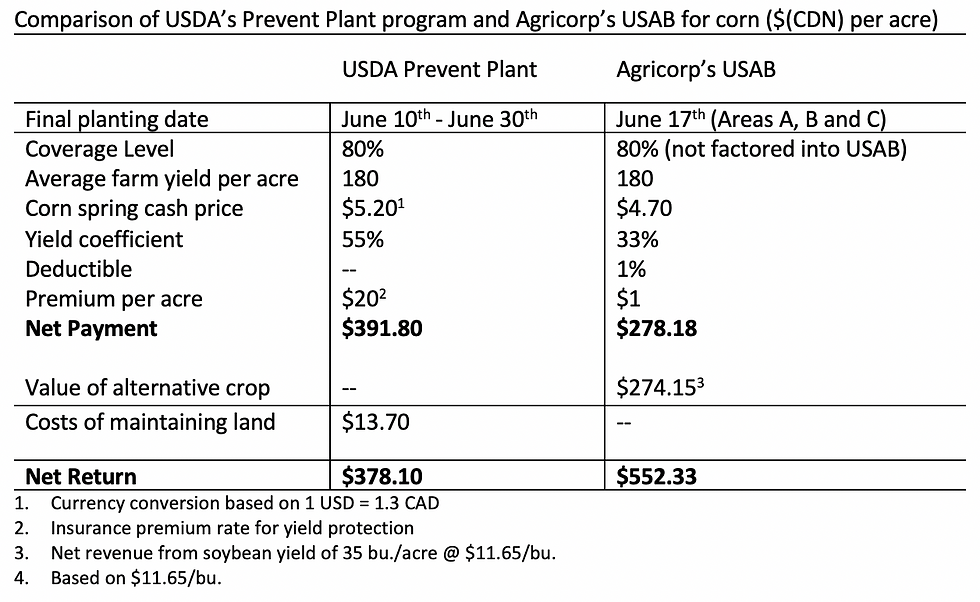Interpreting insurance discussions in Ontario and across the border
- Sean Mitchell

- Jul 5, 2019
- 3 min read
Updated: Aug 15, 2019

After impatiently waiting for an opportunity to make significant progress with this year’s planting, a window of dry weather in late June allowed most Ontario farmers the chance to finish planting.
Still, there remain significant pockets throughout the province where planting is significantly delayed. Even after Agricorp extended the final planting date for corn in area A, B and C until June 17th, this still won’t allow for some producers to finish planting corn. Other areas also received similar extensions.
The situation is arguably worse in parts of the American mid-west, where more than 25% of farmland remains unplanted.
Both in Ontario and south of the border, delayed planting has resulted in speculation that producers should park their planters and look to alternatives such as the US Department of Agriculture (USDA)’s prevent program, or Agricorp’s unseeded acreage benefit (USAB) in Ontario. These programs have rarely been used but producers are interested in whether these preplant insurance programs are right for them given the difficulty of the 2019 planting season.
Assessing how insurance programs function
As planting dates kept getting pushed back due to the wet weather, American corn farmers were faced with three choices on ground originally slotted for corn: (1) plant corn whose yields would likely to continue to fall with the delay, (2) plant soybeans with lower prices and also declining yield prospects, or (3) take an insurance payout. The USDA’s prevent program pays producers a portion of their projected income per acre to forego planting crops which will likely not mature properly. The rational behind these payments is that they are preferable to more expensive production insurance payments, and they save farmers the labour and input costs of planting a crop that is doomed from the outset.

The similarities
Agricorp’s USAB works in a similar way, and both are intended to cover fixed costs and land maintenance, and they reflect the historical yield average farm yield (AFY) of individual producers. After a certain date, the farmer must decide whether to take the insurance payout and the conditions of the program or to take the chance on planting corn or another crop. Each program is also subject to some degree of subjective scrutiny where an agent ensures that reasonable crop management practices are followed.
While both programs are intended to provide support in difficult planting conditions, there are significant differences in the coverage levels and requirements as shown in Table 1. The payouts for each program are illustrated for a farmer with corn selected as their dominant crop and enrolled in a plan with a floating price option with an 80% coverage level and an average farm yield of 180 bushels per acre.
The differences
There are three main differences. First, is the cash price used to determine the value of the crop not planted.
Second, and most significantly is the yield coefficient. The USDA’s prevent plant payment is 55% of the initial revenue guarantee of the insurance, which in the example above is $748.80 (=0.8*180 bu/acre*$5.20/bu), resulting in a payout of $391.80 (=0.55*$748.80-$20). The level of coverage chosen for the final crop does not influence the Agricorp’s USAB payment, which is 33% of the expected value of the crop: $278.18 (=0.33*180 bu./acre*$4.70 bu.*0.99 - 1). There are also minor deductible and premium costs for the USAB.
Third, is the restriction on what can be done with the land after the final plant date. The yield coefficient for prevent plant depends on what is done with the land after the final plant date. It can be reduced to 35% in many circumstances or eliminated entirely if they plant within 25 days of the planting deadline or graze prior to November 1st. In contrast, there are no restrictions on what an Ontario corn farmer can do with the land. It can still be used to grow crops for market, but those crops cannot be insured. If a farmer in Ontario decides to take advantage of this opportunity and plant soybeans after the planting deadline, the break-even yield is 26.5 bu./acre (assuming costs = $308/acre).
At first glance, the prevent plant program for an American farmer is more lucrative than Agricorp’s USAB program. However, this payment declines depending on what the American farmer does with the land while an Ontario farmer receives the same payment regardless. As a result, the net return on the land could be higher for the Ontario farmer provided sufficient yields can be obtained from the crop eventually planted late on the wet land receiving the UAB payment.
Recommended citation format: Mitchell, S. “Interpreting insurance discussions in Ontario and across the border”. Food Focus Guelph (41), Department of Food, Agricultural and Resource Economics, University of Guelph, July 5th, 2019.





Comments